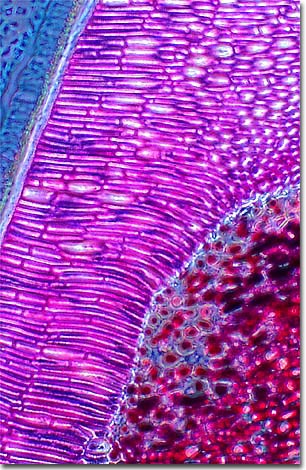Phase Contrast Image Gallery
Black Grape Rot
Black rot, caused by the fungus Guignardia bidwellii is one of the most serious diseases of cultivated grapes in the eastern United States, especially in warm, humid areas. As evidenced by this micrograph, combining phase contrast microscopy with classical histological staining techniques often yields enhancement of cellular features.

Crop losses can be devastating, ranging from 5-80% depending on the weather, the variety of grape being grown, and the amount of disease in the vineyard. The fungus can infect all green parts of the vine but the most damaging effect is on the fruit, which shrivel up into dark-colored mummies.
This fungus reproduces with two types of spores, ascospores and conidia (pycniospores). Ascopores are produced in the grape mummy and forcibly discharged into the air, often traveling considerable distances. Conidia are vegetatively reproduced spores that the fungus uses to propagate, and are spread through rain or irrigation water splashing on the plants.
VIEW THIS SPECIMEN UNDER FLUORESCENCE ILLUMINATION
BACK TO THE PHASE CONTRAST GALLERY
